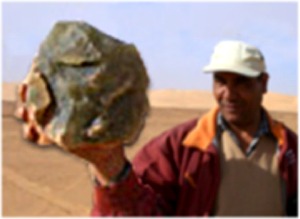Evidence of Ancient Atomic Knowledge?
Page 3
TUT'S GEM HINTS AT SPACE IMPACT

Desert Glass Scarab. What produced the intense heat in the desert?
In 1996 in the Egyptian Museum in Cairo, Italian mineralogist Vincenzo de Michele spotted an unusual yellow-green gem in the middle of one of Tutankhamun's necklaces.
The jewel was tested and found to be glass, but intriguingly it is older than the earliest Egyptian civilisation.
Working with Egyptian geologist Aly Barakat, they traced its origins to unexplained chunks of glass found scattered in the sand in a remote region of the Sahara Desert.
But the glass is itself a scientific enigma. How did it get to be there and who or what made it? The BBC Horizon programme has reported an extraordinary new theory linking Tutankhamun's gem with a meteor.
Sky of fire
An Austrian astrochemist Christian Koeberl had established that the glass had been formed at a temperature so hot that there could be only one known cause: a meteorite impacting with Earth. And yet there were no signs of a suitable impact crater, even in satellite images.
American geophysicist John Wasson is another scientist interested in the origins of the glass. He suggested a solution that came directly from the forests of Siberia. "When the thought came to me that it required a hot sky, I thought immediately of the Tunguska event," he told Horizon.
In 1908, a massive explosion flattened 80 million trees in Tunguska, Siberia. Although there was no sign of a meteorite impact, scientists now think an extraterrestrial object of some kind must have exploded above Tunguska.
Wasson wondered if a similar aerial burst could have produced enough heat to turn the ground to glass in the Egyptian desert.
Jupiter clue
The first atomic bomb detonation, at the Trinity site in New Mexico in 1945, created a thin layer of glass on the sand. But the area of glass in the Egyptian desert is vastly bigger.
Whatever happened in Egypt must have been much more powerful than an atomic bomb.
Impact Simulation
Barakat holds up one of the many, huge chunks of glass in the desert.

A natural airburst of that magnitude was unheard of until, in 1994, scientists watched as comet Shoemaker-Levy collided with Jupiter. It exploded in the Jovian atmosphere, and the Hubble telescope recorded the largest incandescent fireball ever witnessed rising over Jupiter's horizon.
Mark Boslough, who specialises in modelling large impacts on supercomputers, created a simulation of a similar impact on Earth.
The simulation revealed that an impactor could indeed generate a blistering atmospheric fireball, creating surface temperatures of 1,800C, and leaving behind a field of glass.
"What I want to emphasise is that it is hugely bigger in energy than the atomic tests," said Boslough. "Ten thousand times more powerful."
Defence Lessons
The more fragile the incoming object, the more likely these airborne explosions are to happen. In Southeast Asia, John Wasson has unearthed the remains of an event 800,000 years ago that was even more powerful and damaging than the one in the Egyptian desert; one which produced multiple fireballs and left glass over three hundred thousand square miles, with no sign of a crater.
"Within this region, certainly all of the humans would have been killed. There would be no hope for anything to survive," he said.
According to Boslough and Wasson, events similar to Tunguska could happen as frequently as every 100 years, and the effect of even a small airburst would be comparable to many Hiroshima bombs.
Attempting to blow up an incoming asteroid, Hollywood style, could well make things worse by increasing the number of devastating airbursts.
"There are hundreds of times more of these smaller asteroids than there are the big ones the astronomers track," said Mark Boslough. "There will be another impact on the earth. It's just a matter of when."
Horizon: Tutunkhamun's Fireball, made by production company TV6, was broadcast on BBC Two on Thursday, 20 July
1, 2, 3 4 Next>>>
http://s8int.com/atomic1.html